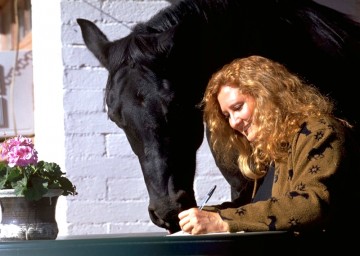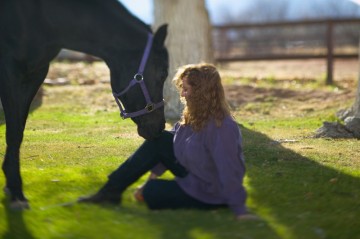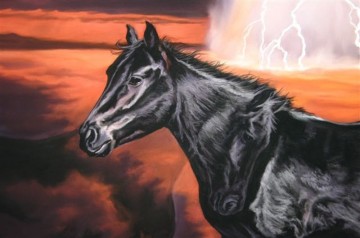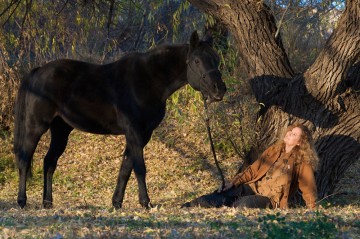
This year marks the 15th anniversary of The Tao of Equus, published in 2001. A lot has changed since Linda Kohanov wrote this adventurous book on the transformational power of the horse-human bond. In 2016, people are much more inclined to treat horses as partners and teachers, rather than as mindless possessions. The fields of equine-facilitated learning and equine-facilitated mental health (which were still in their infancy back when Linda wrote about their genesis in this book) are growing fast. But much of the mystery behind the book’s original inspiration remains.
The Tao of Equus chronicles the author’s unexpected encounters with a black Arabian mare named Tabula Rasa, who became a profound teacher over time. For nearly two decades Rasa helped people from five continents tap the emotional, creative, mythical and spiritual dimensions of existence, while still encouraging her two-legged students to remain grounded and deeply connected to nature.
Rasa left this world in 2011, but the wisdom she helped Linda and others access is still explored in workshops like Black Horse Wisdom, with Rasa’s children and grandchildren continuing to lead the way.
In striving to sum up Rasa’s life and legacy in a multi-media essay, Linda explored the paradoxes that horses somehow integrate when people open their hearts and minds to what these magnificent beings are capable of teaching us—especially when we step out of the saddle and let them lead the way now and then. We hope you enjoy this excerpt. If you would to read the entire piece, which also contains photos, artwork, and songs that Rasa and her herd inspired: http://eponaquest.com/a-tribute-to-tabula-rasa/.
From “A Tribute to Tabula Rasa” by Linda Kohanov
Horses effortlessly and gracefully embody the most profound contradictions: They are simultaneously innocent and wise, never sacrificing one in favor of the other. Experience, parenthood, advanced training, fame, and even trauma cannot mar the purity of spirit they hold so faithfully through the 10,000 joys and 10,000 sorrows of life.
Sitting quietly with Rasa, breathing in sync with her mindful acceptance of each and every moment, entraining with the beat of her massive heart, I always felt a deep, renewing peace engulf me, no matter what trials I might otherwise be enduring. This in itself was a daily miracle. Her presence, however, was powerful, not passive. Horses, she taught me early on, actively mirror the nuances of how people show up each day, highlighting our hidden gifts, our wounds, our vulnerabilities, and our worn-out worldly habits. And yet somehow they manage to be discerning without a hint of judgment, communicating that at the core, we too are beautiful, powerful, and wise, capable of endless renewal.

In the eyes of Tabula Rasa, I came to see human dysfunctions as surface scintillations, dramatic and sometimes irritating to be sure, but certainly not set in stone. Whenever I managed, through grace or sheer stubborn will, to let go of an old pattern and embody a fresh perspective, Rasa would mirror the transformation, welcoming me home to an ever-deeper understanding of who I really was. And without the slightest hint of ambition, she would continually up the ante, stretching, relentlessly, my own limited ideas about my place in the world, my calling, my untapped potential, and even, as it turns out, the nature of reality itself. Because the ultimate contradiction, the ultimate paradox Tabula Rasa brought to light involved embracing logic and mystery simultaneously, treating them as equal partners, as twin forms of consciousness. She even went to the trouble of having twin sons in 2002 to underline that point. Her first-born son, Spirit, against all odds, stayed in this world to eventually sire his own daughter Artemis. His identical twin brother, Sanctus, was stillborn. In one outlandish gesture, Rasa gave birth to life and death simultaneously, vividly and forever connecting us to this world and the other. Sometimes late at night, I still catch a glimpse of Spirit’s brother shadowing him, dancing in the moonlight.

Rasa’s lesson plan for me, and for thousands of people around the world who became her students in one way or another, involved a wildly expanded, inter-disciplinary approach to life. She insisted that we become more effective in navigating the challenges of a concrete, earthly reality, while also exercising our innate yet long-suppressed ability to collaborate with an ephemeral, eternally morphing spiritual reality, to claim our birthright as co-creators in a universe capable of dreaming big dreams. In this effort, Rasa taught us to not just appreciate mystery but to ride it, to use the challenges, frustrations, disappointments and pain of life to exercise a warrior’s courage, not to conquer the known world, but to reach into the fertile darkness of the magnificent void and speak what has never been spoken, write what has never been written, paint what has never been seen, dream what has never been dreamed.
The mystery of creativity and the alchemy of turning pain into inspiration both depend upon accessing what logic can’t touch — without losing your sanity. These are elements of what I came to call “black horse wisdom,” wisdom that’s felt more deeply than it can ever be explained, wisdom we often ignore until some difficulty in life opens up us to other possibilities. In dreams and myths from around the world, the black horse heralds the reassertion of qualities difficult for the well-groomed persona to handle, revolutionary insights and energies that can’t be tamed by polite society. The black horse champions knowledge rejected by the mainstream: instinct, emotion, intuition, sensory and extrasensory awareness, and the human-animal partnership associated with tribal cultures. Science may never be able to dissect this wisdom, to bring it fully into the light of conscious understanding, but through the metaphor of the horse, and through real life interactions with Rasa, I learned to negotiate the outlying areas of human existence, and to a certain extent, map them. For a while, at her urging, I went feral, reveling in the life of a lone artist-adventurer. But the black horse didn’t let me stay there long, emphatically herding me back into the human world, demanding that I translate her silent wisdom into language that twenty-first-century audiences could embrace.

And so in my first book, The Tao of Equus, I told Rasa’s story from this perspective, mixing the earthier, historical and more practical elements of the horse-human relationship with the emotional and spiritual dynamics, struggling to put my most elusive experiences with the black horse into words, fearing all the while that I would be dismissed as crazy, if not actually committed. I was stunned by the power of this approach. Readers from around the world not only wrote me of their own long hidden experiences, they began showing up in person. The black horse stepped forward without hesitation, somehow compelling people to exercise their own intuitive and creative abilities. In her presence, students would be inspired, effortlessly and inexplicably, to draw, paint, write poetry, compose songs and, increasingly, to access a mythic otherworld where past, present and future merged in outlandish yet profound visions of possibility.
And then Rasa upped the ante. As people around the world came to study with both of us, I was thrust into what, for me, was the strangest and most frustrating task of all: combining the sensitivity and optimism of the visionary with the fortitude and realism of a leader. Not just any kind of leader, mind you, but one who was expected to be compassionate, innovative and effective simultaneously. In this effort, through much pain and confusion, I was confronted with our culture’s most cherished notions about power and authenticity. Yet to maintain the crucial creative element that attracted people to our work in the first place, I had to keep my heart open, no matter how much pain was involved. I grappled daily with experiences emphasizing that the unusually potent combination of power and authenticity was a serious double-edged sword, so volatile and dangerous when you’re learning how to use it, yet so essential to personal and social transformation. To make matters worse, I was expected to teach people to wield this heavy weapon as I was initially exploring the art form myself. Developing the muscles just to hold the damn thing up, let alone twirl it Samurai-style without cutting my own arm off, took years of conditioning and experimentation….
As Walter Winchell observed, “Leadership is the capacity to translate vision into reality.” Tabula Rasa understood this, insisting that all her students, me included, move ever more skillfully between practical, earthly existence and that strange, amorphous otherworld where the as-yet-unimagined hovers, waiting, always waiting, for someone with the nerve, endurance, ingenuity, and charisma to coax the formless into form. This, she conveyed silently yet eloquently throughout her life, is how we change the world.
Copyright 2011 by Linda Kohanov
To access the entire multi-media essay, see http://eponaquest.com/a-tribute-to-tabula-rasa/.
For more information on upcoming workshops Black Horse Wisdom and Black Horse Wisdom 2 see http://eponaquest.com/workshop/black-horse-wisdom/ and http://eponaquest.com/workshop/2045/.